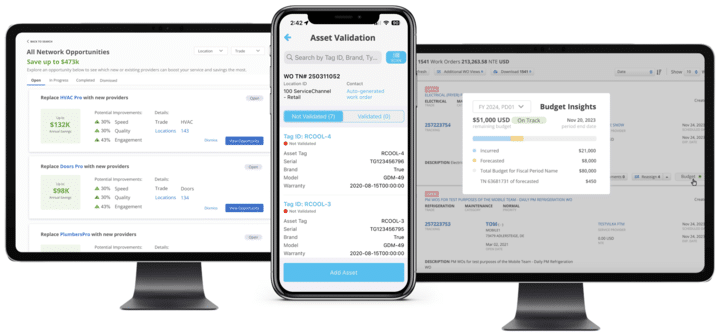EAM vs ERP: Understanding the Differences
Explore the differences between EAM vs ERP Systems, similarities, choosing between them, and how to successfully integrate them into your business operations.
Maintaining and monitoring IT (information technology) and physical assets are crucial business processes. Regarding asset management, you want to get the enterprise software services and functionality that best suit your business needs. Computerized maintenance management systems (CMMS) are options many businesses turn to for their asset management solutions.
Enterprise asset management (EAM) and enterprise resource planning (ERP) are popular software systems companies use to track and maintain their company assets.
While there is much to consider regarding CMMS vs. EAM software, here we’ll discuss the similarities and key differences between ERP and EAM systems to help determine which works best for your business operations.
What is EAM?
An enterprise asset management (EAM) system is software that’s used for monitoring and maintaining the life cycles of complex physical assets. Factory equipment, facility systems, and vehicles are some examples of physical assets an EAM system might help manage. By optimizing equipment life cycles, companies can extend the usability of assets and impact an organization’s financials by reducing maintenance and replacement costs.
Key Features of EAM Systems
While not limited to these capabilities, an EAM system typically includes these features:
- Centralized repository
- Maintenance systems
- Planning and scheduling
- Supply chain management
- Asset management
What is ERP?
An enterprise resource planning (ERP) system manages a vast array of tasks and is used across a wide range of industries. Companies often choose an ERP as a facility management solution for its ability to manage assets and business operations, such as tracking financial transactions and employee performance.
Key Features of ERP Systems
An ERP system usually possesses several asset management and monitoring functions but typically includes the following capabilities:
- Total lifecycle management
- Centralized asset information
- Inventory management
- Risk management
- Asset performance management
Similarities Between EAM vs. ERP
An EAM and an ERP system are both used to manage physical assets but are very different types of platforms. The two systems share many key similarities, and people often use the terms EAM and ERP interchangeably. The two platforms typically share these key features in an asset management process.
Asset Maintenance
Both tools typically provide asset maintenance functionality. An enterprise resource management (ERP) system takes a broader view of the organization as a whole and usually includes basic-level asset management and maintenance features. Enterprise asset management (EAM) systems place a more intense focus on managing the maintenance and life cycles of physical assets.
Centralized Repositories
EAM and ERP systems both provide a centralized location for storing and managing data. A central repository enables applications and smart equipment to access and analyze or process this information efficiently as needed.
Cross-Collaboration
A centralized repository enables different departments and teams to access and share information. This all-inclusive access offers EAM and ERP cross-collaboration capabilities to keep all teams on track and give them greater capability to manage assets and meet maintenance schedules.
Data Management
ERP software and EAM software both possess robust data-management capabilities. However, their focus differs. EAM systems data focuses primarily on managing physical assets, including monitoring their condition and gathering numerous other asset data points. ERP data focuses on overall business operations. Finances, sales, production tracking, and human resources are common examples of data that an ERP might manage.
Differences Between EAM vs. ERP
While there is plenty of overlap, ERP and EAM software each serves different needs. An organization may require one system or the other, but no rule says a company can’t utilize both. Comparing these key differences can help you better determine which software to choose or if both will best help manage your organization’s assets and meet your operational needs.
Purpose and Scope
An EAM solution focuses on managing assets. It schedules maintenance-related tasks and offers preventive maintenance recommendations by monitoring the equipment’s condition and assessing maintenance needs. An ERP software scope is more far-reaching, covering a wide range of business processes, from supply chain monitoring to tracking company activities.
Functionality
ERP and EAM software possess widely different core functions. An EAM solution emphasizes maintenance, focusing on asset reliability and extending equipment lifespans. While an ERP solution may touch on asset management to a point, it emphasizes the organization as a whole, integrating finance, human resources, customer relationship management, and other business functions.
Use Cases and Industries
Asset management impacts productivity and, ultimately, company costs. EAM software’s relevance for maintenance and operations teams makes it an ideal software solution for industrial environments. A freight operation or manufacturing plant will likely prioritize an EAM solution.
ERP software touches multiple departments and business roles. This makes it an excellent choice for office environments and customer-facing businesses.
The distinct capabilities of each platform make it likely that a large business could benefit by employing both in their company. Focusing an EAM software tool on equipment and physical asset management while utilizing ERP solutions for more complex business operations can help a large company run more efficiently all the way around.
Data Management
ERP and EAM solutions both possess powerful data management capabilities. However, the primary focus differs greatly between the two.
EAM focuses on asset-specific data. The software can help create maintenance schedules, provide operational visibility, and organize maintenance-related tasks by analyzing information related to an organization’s physical assets.
ERP takes a more global view of an organization’s business requirements. Such a platform is ideal for tracking data related to asset lifecycle management and analyzing procurement models. It’s also a useful solution for gathering customer experience information, analyzing purchasing patterns, and a host of other day-to-day business-related tasks.
Choosing Between EAM vs. ERP
While integrating an EAM and ERP system offers the maximum outcome for an organization, circumstances may leave you choosing one or the other. There is much to consider when selecting between an EAM and an ERP. When determining which system will best suit your company’s needs, consider these items:
- Your business’s primary focus
- The need to maintain physical or digital assets
- The size of your organization
- Operational requirements
- Ease of integration with existing systems
Integrating EAM and ERP Systems with ServiceChannel
Facilities management requires a lot of data tracking and asset maintenance. Powerful software tools are vital for keeping up in today’s competitive business environment. A CMMS, EAM, and ERP each contribute unique strengths toward this endeavor.
The ServiceChannel facilities management platform integrates EAM and ERM systems, providing users with a robust suite of effective business and asset management tools. Contact ServiceChannel today and move one step closer to total facility efficiency.



